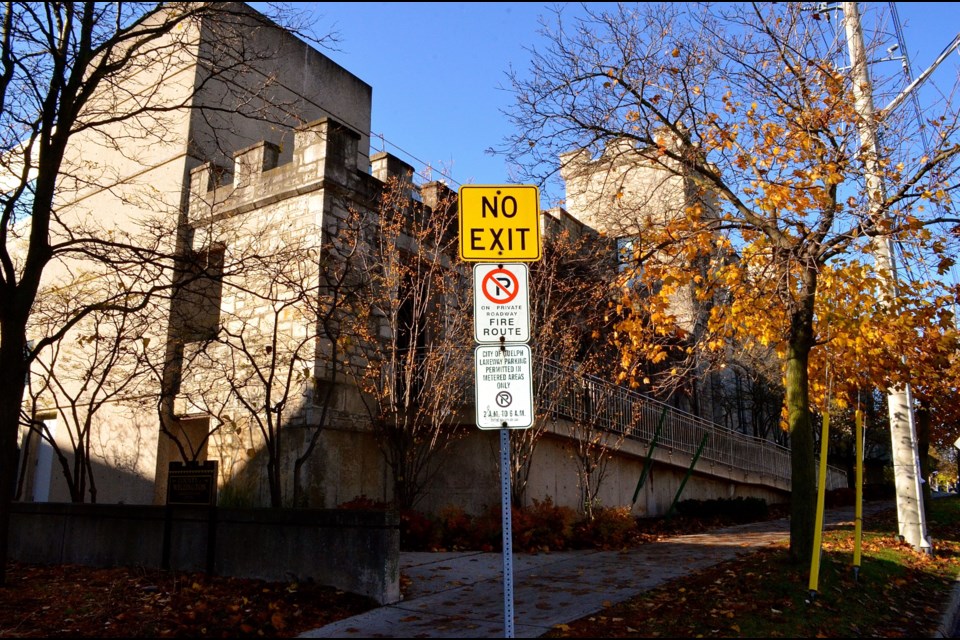There is a garden path that cuts behind the County of Wellington Courthouse and Administrative Centre on Woolwich Street with a bench where county staff and others often sit during their coffee and lunch breaks.
The path is enclosed by a high stone wall that runs along the south west edge of the property, a remnant of the oldest public building in the city – the first county jail, or gaol, built in 1839.
Stone from the old jail was reused to build a new jail at the site in 1911 as well as a new county courthouse and Governor’s Residence.
The new jail was built to house 28 inmates but historian Ron Brown records in his book Behind Bars: Inside Ontario’s Heritage Gaols that it was nearly double capacity with 55 prisoners “crammed into tiny cells” by the time it was closed in 1980.
The prisoners were then transferred to the new Wellington Detention Centre on Stone Road.
The vacant buildings were restored and renovated shortly after to house the County of Wellington Administrative Centre.
It was designated a heritage site in 1983 and the gardens and grounds around the historic buildings have become popular with local photographers for wedding and engagement photos. Many happy couples pose along the garden path blissfully unaware of the dark history contained within the aging limestone walls.
The path cuts through the old exercise or “airing” yard where prisoners would get some fresh air and a little bit of vitamin D while they served out their sentences. For some those stone walls were the last thing they’d see because the exercise yard had a dual purpose.
It was the site of at least nine executions between 1847 and 1919.
Stories about the site being haunted go back many years and that has made it a regular stop for Greg Taylor during his guided Ghost Walk of Guelph tours.
“In and around the courthouse, my prior interviews revealed that some of those inside had an odd feeling of being watched,” said Taylor. “In one office in particular someone told me they saw shadows of a person walking by on the wall of someone who wasn't there.”
County photographer Chris Piccinetti has worked at the site for several years and even had a desk in the basement of the old jail.
“I’ve never seen anything strange but people often talk about it,” he said. “I’ve heard stories about people seeing images in a window or shadows moving down the hall.”
Taylor has been leading Ghost Walk of Guelph tours through the city since 2013 and has yet to see a ghost at any of the reputedly haunted locations in the downtown area. The closest he has come to a measurable brush with the paranormal occurred on the grounds of the old jail.
“I took a private group on a walk - a group of girls on a Grade 9 overnight,” said Taylor. “One brought an EMF detector and nothing happened all during the walk until the courthouse when it lit up like a Christmas tree.”
Public hangings were a form of community entertainment during the mid 1800s and people traveled from as far away as Hamilton and Toronto to witness executions at the jail in Guelph.
The first public hanging in Guelph was that of Charles Coghlin on July 01, 1847. He was convicted of stabbing and killing his neighbour Richard Oliver during a drunken fight on Eramosa Road near what is now the Bullfrog Mall. The fight was related to a family feud that arose from religious antagonism between Irish Catholics and Protestants.
There were four more public hangings documented at the jail over the next four decades including the only black man on record Henry White convicted of killing his common-law wife Susannah on Aug 11, 1875 and hanged Dec 23, 1875.
The last public hanging was that of fraudulent bookkeeper William Harvey convicted of killing his wife Mathilda and two of their children in March 1889 and hanged in Nov 29, 1889.
Harvey’s execution was botched and as many as 75 witnesses, including a group of boys who had climbed nearby trees to peer over the wall, looked on in horror as the condemned man slowly strangled to death.
The macabre display put an end to public hangings at the jail but at least four more men were executed there by 1919.
Some of the condemned men went to their graves as repentant killers, some cheated the hang man and some died proclaiming their innocence.
“At 3 a.m., July 4, 1916, Tony Legato, waiting to be hung for murder, committed suicide,” said Guelph author and historian Bonnie Durtnall. “Some say James Giovanzzi, executed there in 1919 for murder, might have been innocent. He never admitted to the crime, even on the gallows unlike Henry White who freely admitted both his sin and his guilt and actually thanked the governor of the Gaol and Mr. Taylor, the turnkey for their 'kind treatment'."
The stories of these condemned men continue to feed into the legends of ghosts walking the grounds of the old jail especially this time of year and they will remain a part of the dark history of Guelph’s first gaol and gallows.



